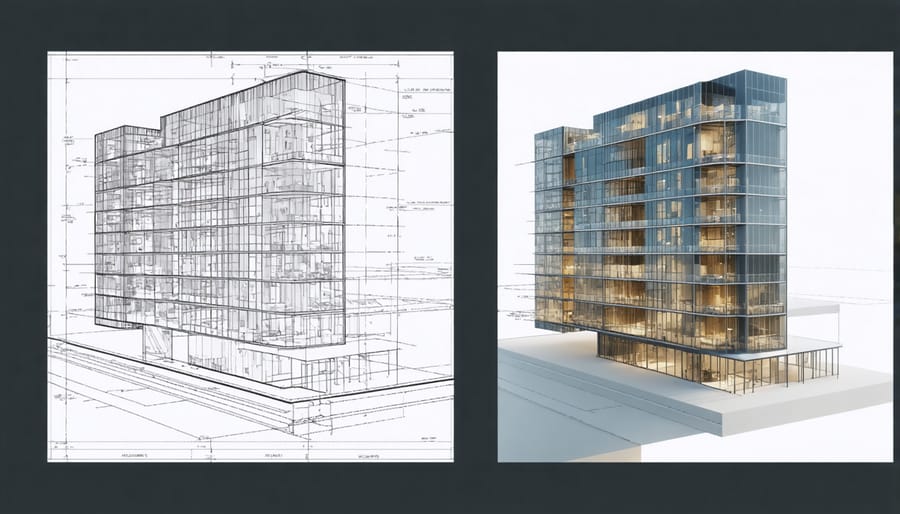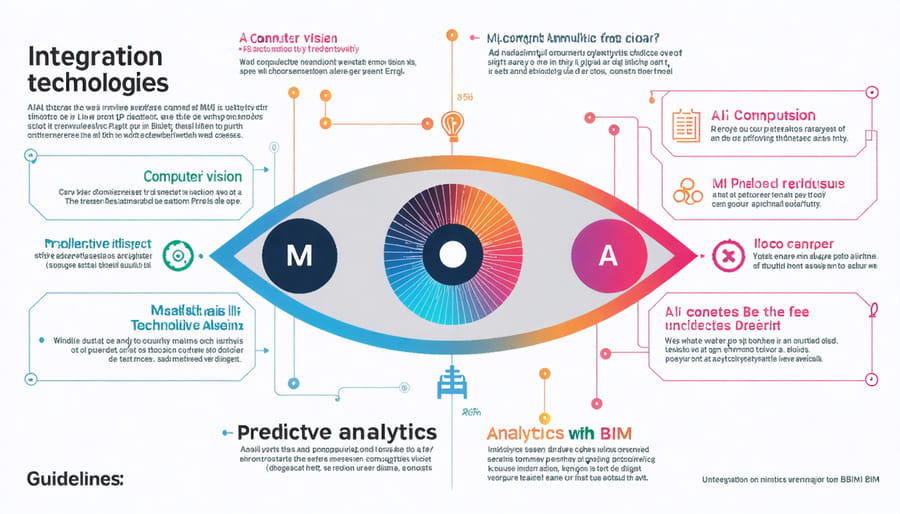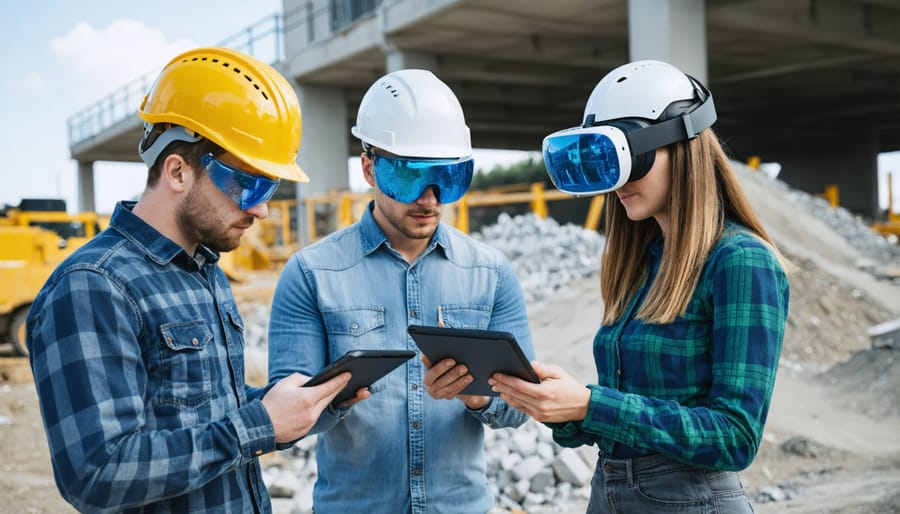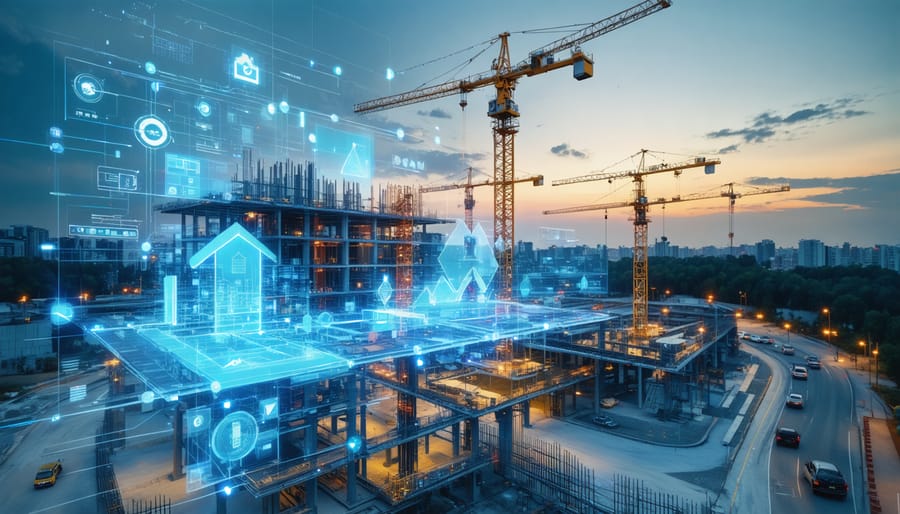Building Information Modeling (BIM) has revolutionized construction project management, transforming traditional workflows into dynamic, data-driven processes that enhance project delivery and operational efficiency. As AI in construction management continues to evolve, BIM integration has become essential for successful project execution in today’s complex built environment.
Modern construction projects generate massive amounts of data, and BIM serves as the central nervous system, coordinating information across multiple stakeholders while reducing errors, minimizing rework, and optimizing resource allocation. This technological framework enables project managers to visualize, analyze, and control every aspect of construction – from initial design through completion and beyond into facility management.
The convergence of BIM with advanced project management methodologies has created unprecedented opportunities for improving construction outcomes. Real-time collaboration, clash detection, cost estimation, and schedule optimization are no longer future possibilities but present-day necessities. Industry leaders leveraging BIM report significant improvements in project delivery times, cost control, and quality assurance, while maintaining better compliance with regulatory requirements.
As construction projects grow increasingly complex, BIM’s role in project management becomes more critical, offering sophisticated tools for risk management, sustainability analysis, and stakeholder communication. This integration represents not just a technological upgrade but a fundamental shift in how construction projects are conceived, planned, and executed.
The Evolution of BIM in Construction Management
Traditional BIM vs. AI-Enhanced BIM
Traditional BIM has long served as a cornerstone of modern construction drawing management and project coordination, offering 3D modeling, clash detection, and basic simulation capabilities. However, the integration of AI has transformed these conventional features into more powerful, predictive tools that dramatically enhance project outcomes.
Where traditional BIM requires manual input for design modifications and conflict resolution, AI-enhanced BIM systems can automatically identify potential issues and suggest optimal solutions. For instance, while conventional BIM might flag a clash between mechanical and structural elements, AI-powered systems can propose multiple resolution options based on historical project data and design parameters.
Another significant advancement is in project scheduling and resource allocation. Traditional BIM platforms provide basic 4D scheduling capabilities, but AI-enhanced systems can analyze numerous variables simultaneously, including weather patterns, material delivery times, and labor availability to generate more accurate and adaptive project timelines.
Cost estimation and budget management also see marked improvements. While traditional BIM offers quantity takeoffs and basic cost calculations, AI integration enables dynamic cost optimization by analyzing market conditions, supplier data, and regional pricing variations in real-time.
The enhanced version also excels in quality control and risk management, using machine learning algorithms to predict potential construction issues before they occur, whereas traditional BIM relies primarily on manual oversight and experience-based decision-making.

Key AI Technologies Driving BIM Innovation
Artificial Intelligence is revolutionizing Building Information Modeling through several key technologies that enhance project management capabilities and decision-making processes. Machine learning algorithms are now capable of analyzing vast amounts of historical project data to optimize design solutions, predict potential construction issues, and automate routine modeling tasks that previously required significant manual input.
Computer vision technology has become particularly influential in BIM implementation, enabling automated progress monitoring through comparison of as-built conditions with 3D models. By processing images and video feeds from construction sites, these systems can detect discrepancies between planned and actual construction, identify safety hazards, and track installation accuracy in real-time.
Predictive analytics represents another cornerstone of AI-enhanced BIM, utilizing historical project data and real-time inputs to forecast project outcomes, identify potential delays, and optimize resource allocation. These systems can analyze patterns in construction sequences, weather impacts, and resource utilization to provide actionable insights for project managers.
Natural Language Processing (NLP) is improving how teams interact with BIM models, allowing for intuitive voice commands and automated document analysis. This technology helps in extracting relevant information from construction documents, specifications, and regulatory requirements, integrating them seamlessly into the BIM environment.
Generative design algorithms are pushing the boundaries of what’s possible in architectural and engineering solutions. These systems can rapidly generate multiple design alternatives based on specified parameters, considering factors such as cost, energy efficiency, and structural integrity. This capability enables project teams to explore innovative solutions while maintaining practical constraints.
The integration of these AI technologies within BIM platforms is creating more intelligent, responsive, and efficient project management systems, fundamentally changing how construction projects are planned, executed, and monitored.

Real-Time Project Management Applications
Automated Progress Monitoring
The integration of AI with BIM has revolutionized progress monitoring in construction projects, enabling unprecedented levels of automation and accuracy in tracking project milestones. AI-powered project management tools now analyze BIM models in real-time, automatically comparing as-built conditions with planned specifications through computer vision and sensor data.
This automated monitoring system continuously tracks multiple project parameters, including construction progress, resource utilization, and schedule adherence. Advanced algorithms process data from various sources, such as drone imagery, IoT sensors, and laser scanning, to generate detailed progress reports without manual intervention. The system can detect deviations from the planned BIM model, alerting project managers to potential issues before they escalate into significant problems.
Real-time reporting capabilities enable stakeholders to access up-to-date project status through customizable dashboards. These dashboards visualize critical metrics, including percentage completion, resource allocation, and quality compliance. The system also generates predictive insights, forecasting potential delays and suggesting corrective actions based on historical project data and current progress patterns.
The automation of progress monitoring has significantly reduced the time spent on manual reporting while improving accuracy and transparency. Project managers can now focus on strategic decision-making rather than routine data collection and analysis, leading to more efficient project delivery and better resource management.

Risk Assessment and Mitigation
The integration of BIM with advanced AI algorithms has revolutionized risk assessment and mitigation in construction project management. By analyzing vast amounts of project data, AI-powered BIM systems can identify potential risks before they materialize, enabling proactive decision-making and more effective risk management strategies.
These intelligent systems continuously monitor project parameters, including structural integrity, cost variations, schedule delays, and safety concerns. Through machine learning algorithms, the system learns from historical project data to predict potential issues and suggests mitigation strategies based on successful past solutions. This predictive capability allows project managers to address risks at their earliest stages, significantly reducing their impact on project outcomes.
Real-time clash detection and interference checking have become more sophisticated with AI integration, automatically identifying spatial conflicts and suggesting optimal solutions. The system also evaluates environmental factors, regulatory compliance requirements, and resource availability constraints to provide a comprehensive risk assessment framework.
Furthermore, AI-enhanced BIM facilitates better stakeholder communication regarding risks through visualization tools and automated reporting. Project teams can simulate various scenarios and their potential outcomes, enabling informed decision-making based on quantifiable data rather than intuition alone.
The system’s ability to continuously learn and adapt means that risk assessment becomes more refined and accurate over time, creating a valuable knowledge base for future projects and improving overall project resilience.
Resource Optimization
In modern construction project management, AI-powered BIM systems have revolutionized how resources are allocated and scheduled. These intelligent systems leverage machine learning algorithms to analyze historical project data, current resource availability, and project requirements to optimize resource allocation efficiently. By implementing advanced resource optimization strategies, project managers can significantly reduce waste and improve productivity.
AI-BIM tools excel at predicting resource demands throughout different project phases, enabling proactive planning and preventing bottlenecks. These systems can automatically adjust schedules based on real-time data, considering factors such as weather conditions, material delivery delays, and workforce availability. The intelligent scheduling capabilities ensure optimal resource utilization while maintaining project timelines.
Furthermore, these tools provide detailed insights into resource consumption patterns, helping managers make data-driven decisions about equipment deployment, material procurement, and workforce allocation. The system can identify potential conflicts in resource requirements across different project components and suggest alternative solutions before problems arise.
One of the most significant advantages is the ability to simulate various resource allocation scenarios, allowing project managers to evaluate different approaches and select the most cost-effective solution. This predictive capability helps minimize downtime, reduce operational costs, and ensure smooth project execution while maintaining quality standards.
Implementation Challenges and Solutions
Technical Integration Hurdles
The integration of BIM in construction project management often faces several technical hurdles that organizations must navigate carefully. One primary challenge is system interoperability, where different software platforms and tools struggle to communicate effectively, leading to data translation issues and potential information loss during file exchanges. This is particularly evident when collaborating with stakeholders using various BIM applications and versions.
Infrastructure requirements present another significant challenge. BIM implementation demands robust hardware systems, high-speed internet connectivity, and substantial data storage capabilities. Many construction sites, especially in remote locations, may lack the necessary technological infrastructure to support real-time BIM collaboration and data sharing.
Data standardization and management pose additional complications. Organizations must establish consistent protocols for data input, file naming conventions, and model development to ensure seamless collaboration. The absence of standardized practices can result in confusion, duplicated efforts, and compromised model integrity.
Training requirements and technical expertise gaps often slow down BIM adoption. Construction professionals need comprehensive training to effectively utilize BIM tools, understand modeling standards, and interpret complex data sets. This learning curve can temporarily impact project timelines and productivity.
Solutions include implementing cloud-based BIM platforms to improve accessibility and collaboration, establishing clear BIM execution plans with standardized protocols, and investing in regular training programs. Additionally, adopting open BIM standards and utilizing middleware solutions can help address interoperability issues while ensuring smooth data exchange across different platforms.
Team Training and Adoption
Successful implementation of AI-enhanced BIM systems requires a strategic approach to team training and adoption. Organizations should begin by assessing their current technological capabilities and aligning them with project management best practices to create a tailored training program.
A phased implementation approach typically yields the best results. Begin with a core team of early adopters who can later serve as internal champions and mentors. This group should receive comprehensive training on both BIM fundamentals and AI integration capabilities, ensuring they understand the system’s full potential and limitations.
Regular workshops, hands-on training sessions, and real-world practice scenarios help team members gain confidence in using the new tools. Documentation and standard operating procedures should be developed and maintained, providing clear guidelines for different user roles and responsibilities.
Continuous feedback loops are essential for measuring adoption success and identifying areas requiring additional support. Organizations should establish key performance indicators (KPIs) to track progress, such as user proficiency levels, time saved on tasks, and error reduction rates.
Change management principles should be applied throughout the transition, addressing resistance and concerns proactively. Regular communication about implementation milestones, success stories, and lessons learned helps maintain momentum and engagement across the organization.
Future Prospects and Industry Impact
Emerging Technologies and Integration
The convergence of artificial intelligence and BIM technology is ushering in a new era of construction project management capabilities. Machine learning algorithms are now being integrated with BIM platforms to enable predictive analytics for project timelines and cost estimation, offering unprecedented accuracy in project forecasting. These AI-powered systems can analyze historical project data to identify potential risks and suggest mitigation strategies before issues arise.
Augmented and virtual reality technologies are being seamlessly integrated with BIM models, allowing project teams to visualize and interact with digital twins in real-time. This advancement enables stakeholders to make informed decisions through immersive site walks and detailed inspections of complex building systems before physical construction begins.
Digital fabrication and robotics are emerging as key technologies that leverage BIM data for automated construction processes. Advanced robotics systems can now interpret BIM models to perform tasks such as 3D printing of building components and automated quality inspections, significantly reducing human error and improving construction efficiency.
The Internet of Things (IoT) integration with BIM is revolutionizing project monitoring and facility management. Smart sensors connected to BIM platforms provide real-time data on construction progress, environmental conditions, and building performance, enabling proactive maintenance and optimal resource allocation.
These emerging technologies are not just enhancing existing BIM capabilities but are fundamentally transforming how construction projects are planned, executed, and managed, paving the way for more sustainable and efficient building practices.

Industry Transformation Outlook
Industry experts predict that AI-powered BIM will revolutionize construction project management over the next decade. According to recent research by McKinsey, construction firms implementing advanced BIM solutions could see productivity gains of up to 15-20% by 2025. The integration of machine learning algorithms with BIM is expected to enable predictive analytics for project planning, real-time risk assessment, and automated design optimization.
Leading construction technology consultants anticipate that by 2030, AI-BIM platforms will become standard practice in large-scale construction projects. These systems will offer enhanced capabilities such as autonomous clash detection, instant cost estimation updates, and intelligent scheduling that adapts to real-time project conditions. The emergence of digital twins, powered by AI-BIM integration, will allow project managers to simulate and optimize construction processes before physical implementation.
Environmental sustainability is another key driver of future AI-BIM development. Industry forecasts suggest that AI algorithms will increasingly focus on analyzing building performance data to optimize energy efficiency and reduce carbon footprints. This trend aligns with growing regulatory pressure and client demands for sustainable construction practices.
However, experts caution that successful transformation will require significant investment in workforce training and technology infrastructure. Construction firms must prepare for this evolution by developing clear digital adoption strategies and fostering a culture of continuous learning. The companies that embrace these changes early are likely to gain substantial competitive advantages in the evolving construction landscape.
The integration of Building Information Modeling (BIM) in construction project management represents a transformative shift in how the industry approaches design, planning, and execution. Throughout this exploration, we’ve seen how BIM technology has become an indispensable tool for modern construction professionals, offering unprecedented levels of collaboration, visualization, and efficiency.
Key takeaways demonstrate that successful BIM implementation requires a strategic approach combining technological infrastructure, skilled personnel, and standardized processes. Construction organizations that have embraced BIM report significant improvements in project outcomes, including reduced rework, better cost control, and enhanced stakeholder communication.
For construction professionals looking to maximize BIM’s potential, consider these actionable recommendations:
1. Start with a clear implementation strategy that aligns with your organization’s capabilities and project requirements
2. Invest in comprehensive training programs for team members across all relevant disciplines
3. Establish standardized BIM protocols and workflows before launching major projects
4. Prioritize interoperability when selecting BIM software and tools
5. Regularly assess and update BIM processes based on project feedback and outcomes
The future of BIM in construction project management points toward increased integration with emerging technologies like artificial intelligence, machine learning, and Internet of Things (IoT) sensors. Forward-thinking organizations should prepare for this evolution by building scalable BIM frameworks that can accommodate these advances.
Remember that successful BIM adoption is not merely about implementing new software—it’s about transforming how project teams collaborate, communicate, and deliver value. By focusing on both the technical and human aspects of BIM implementation, construction professionals can position their organizations for sustained success in an increasingly digital industry.
As the construction sector continues to evolve, those who master BIM’s capabilities while staying adaptable to new developments will maintain a competitive advantage in the market. The investment in BIM technology and expertise today will yield significant returns in project efficiency, quality, and profitability tomorrow.

